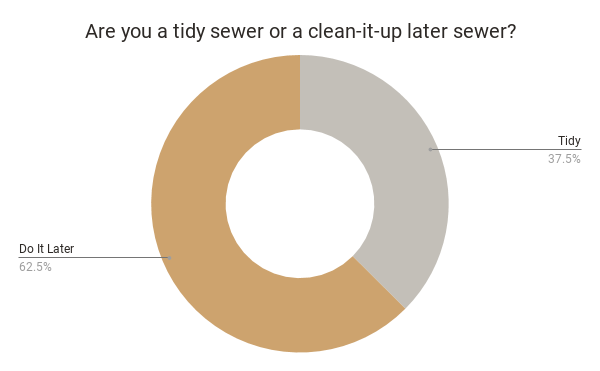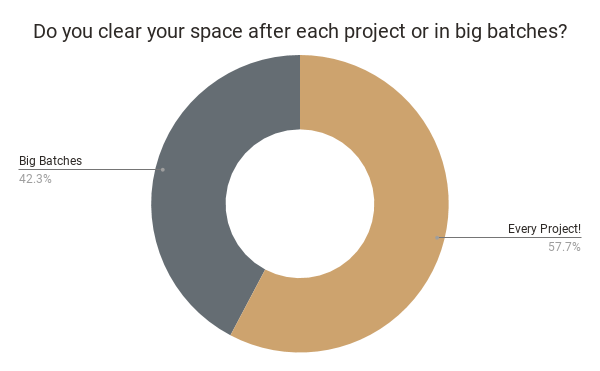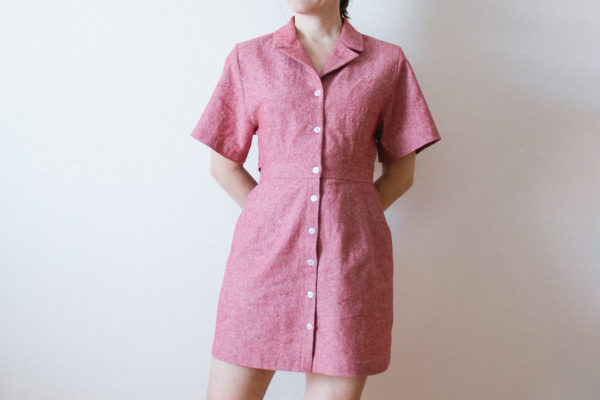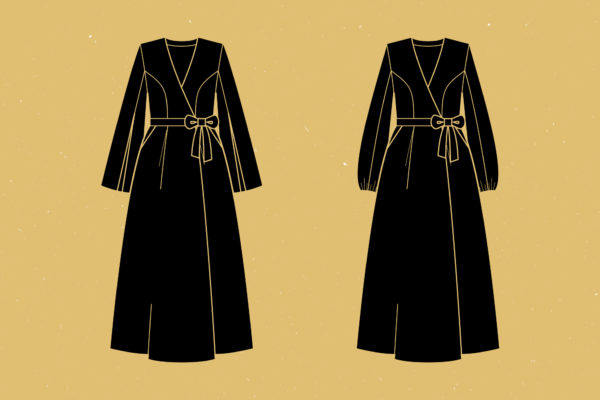Earlier this year we took a poll on Instagram about your tidying habits when it comes to sewing, and asked for your favorite tips to keep your projects and space organized. We received so much great feedback, and we thought there was no better time to share it than the beginning of Spring! So if you’re ready to get your sewing space organized, here are our favorite tips and tricks from fellow sewists.
When it comes to cleaning and being tidy (or not!), there is no right or wrong way to go about it. It’s a matter of figuring out what works for you, your creative process, and your lifestyle. We conducted a few non-scientific polls to see whether there was a strong preference for when and how often you clean up your projects, and unsurprisingly, the answers were split.


While most people prefer to save their tidying for the end of every project, many people prefer to clean as they go, while others like to work on several projects before tidying in one big batch. As @opinionatedcarrot put it:
“Sewing time is not cleaning time, I do it separately.”
For those who do clean as they sew, many people suggested placing a small bin, bowl, or basket near your sewing space to collect waste. If sewing-related castoffs need to be sorted (for example, paper trimmings to be recycled, 100% cotton thread to be composted, etc.), having dedicated receptacles will save time and keep your space looking neat.
Some people told us that they tackled their aversion to cleaning by setting a five minute timer for themselves at the end of every sewing session. While the timer is running, they will focus solely on clearing the space, before walking away to go do something else.
“Everything has a place and everything in its place.”
This refrain was far and away the number one response we received on how to keep your space organized! It makes perfect sense, if items don’t have a home, then it’s impossible to ever put them away—regardless of whether you have a dedicated space to sewing or not.

In fact, when it comes to sewing rooms and staying organized, many of you said less is more. When your sewing table is also the dining room table, or you have a small home, you are forced to clean up after yourself after every session. A lack of storage space also means you must be intentional about what you purchase, which can help prevent you from acquiring more fabric or notions than you need.
For the supplies you do have, it’s important to have a dedicated spot for them, and know where they are. Transparent boxes make it easy to see what you have (and were a particularly popular recommendation), but labels are a good alternative and can be very helpful for keeping track of things. For very large fabric or pattern collections, using an app like Pinterest or Notion to catalogue what you have can make project planning much easier. I personally like to use Trello, and you can see some of my own tutorials for ideas for how to set up your own digital catalogue.
Finally, what about projects you’re currently working on? Especially in a smaller space, it’s often not feasible to just leave them out until the next time you sew again. For storing these, dedicated bins, boxes, or drawers were highly recommended by other sewists. You can keep all of your supplies for a project in a single spot, making it easy to pull it out the next time you want to work on it. This is also handy for when you have many projects going at the same time, or putting together future projects you already have planned.

Popular Tools
In addition to the tips above, we also received many recommendations for supplies to make storage easier. Keep in mind that these are just suggestions, and might not be an ideal solution for everybody. Don’t be afraid to experiment and see what works best for you and your sewing space!
- Pegboard. Commonly found in workshops of all kinds, pegboards are beloved by those who sew because they are a great way to store supplies like thread, scissors, and rulers vertically. They can be easily painted to match your decor, and give you quick access to your most commonly used tools. They are typically found at hardware and home improvement stores.
- Magnets. From needles and pins to bobbins and scissors, magnets can be used in a variety of different ways to store and clean up sewing supplies. Magnetic pin cushions are an easy and effective way to quickly pick up pins, while long magnetic strips can be used similarly to pegboards to store metal supplies like scissors vertically.
- A bullet journal or notebook to keep track of supplies, projects, and sewing plans. There is no reason to go digital when it comes to cataloguing your patterns and projects, and in fact many people prefer the simplicity of pen and paper. Writing down what you have and what you want to do with it is an easy way to keep track of all those great ideas you have for particular fabrics and patterns, or adjustments you may have had to make for certain projects.
Of course, the less you have, the easier it is to keep tidy! The most straightforward advice we received? Don’t buy fabric or supplies that you don’t have the space for. While there is an endless list of sewing gadgets and notions available on the market, the list of supplies you need to sew is relatively small. Stay intentional with your planning and purchasing, and your space will be all the tidier for it.
That is it for our roundup of sewing organization advice. It was so fun to hear everybody’s ideas, and we hope you picked up a new idea or two for your sewing space. Do you have advice to share that we missed? Let us know!
2 commentaires
Sylvie, April 9 2021
We found these double gauze and boiled wool fabrics on rascol.com 🙂



Kathy Bringle, April 9 2021
I love the fabric in the pictures above. Where could I find them?
Thx
Kathy